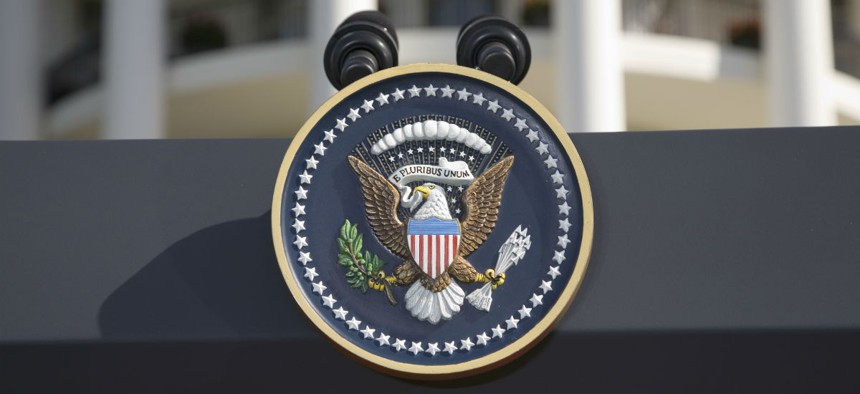
The presidential seal on a podium outside the White House. Joseph Sohm/Shutterstock.com
10 Things to Know about the President’s Management Agenda
It is different in virtually every respect from the plans of previous administrations.
The President’s Management Agenda, released by the White House on March 20, is a fascinating document, different in virtually every respect from the plans of previous administrations. Here are 10 reasons why.
- It’s a big deal. The agenda goes right after the fundamental challenge at the very start: citizens’ declining trust in government. And it pins the blame for low trust directly on the government’s poor performance. Problems flow from files of outdated regulations, inadequate collaboration across agencies, a failure to bring data to bear in important questions, and antiquated technology. The plan begins with a very frank admission that trust in government is at an historic low—and that the cause flows from government’s poor performance.
- It isn’t a “drain the swamp” report. It’s a mandate to make government work in the areas where citizens expect it to work. The management agenda isn’t remotely connected with much of the rhetoric swirling around Washington. In fact, there’s a graphic (p. 4) that makes the powerful point that people want government to work—and that too often it under-performs.
- It’s goal-driven. Mission is first in every part of the agenda. There’s plenty of talk about process reform, but mission drives every bit of it. This is an agenda that builds—perhaps surprisingly—a powerful case for a strong and effective government.
- It’s a plan for the long haul. Most previous management agendas had narrow time frames, focused on months with targets aimed at the end of presidential administrations. This report says “The vision for reform must be multi-generational.” In fact, “We cannot pursue short-term fixes only to see government quickly become outdated once again.” The agenda says explicitly that real transformation will require work far beyond the end of this administration.
- It’s a focus on administrative action, not a legislative agenda. There are calls sprinkled through the report for new laws, but the agenda’s call for reform rests on the executive branch. Most of what the agenda calls for can be done without congressional action, a critical strategy at a time when any congressional action on anything important is elusive.
- It builds on a small collection of big tools. The agenda isn’t a rearranging-the-deck-chairs kind of plan. It focuses clearly on three big drivers of change: better information technology, better use of data, and a workforce matched to the mission of a 21st century government. That’s remarkably laser-like, compared with previous management agendas.
- It uses the language of data. The language is very different from that of previous initiatives. Everything about the agenda is about learning what works, building a language of change based on real-world/real-time data, and fitting government’s workforce with the capacity to drive results.
- It reaches far in measuring results. The Bush management agenda focused on outputs and had stoplights to measure progress. The Obama management agenda built on agency-driven outcomes, with agency-defined measures of success. The Trump management agenda seeks broad results that connect back to the underlying problem of trust in government: improving the customer experience, continuous improvement in operations, and shifting government activities from low-value to high-value work. This is a much bigger bite of a much larger apple.
- It sees a very positive role for government employees. In this document, government workers aren’t monstrous swamp-dwellers. Rather, they are the instruments of the work that citizens expect government will do. It’s been a long time since a presidential-level document frames such a positive role for government employees. The role is challenging—the agenda calls for a radical transformation of the federal workforce. But it makes the case for doing just that to make public employees even more effective—and important.
- It’s clear about the who and the what. All of the specific cross-agency priority goals identify the challenge, what it seeks to accomplish, how reform will work—and, most importantly, what success looks like and who will be responsible for accomplishing it. The range of issues and the connect-the-dots pieces are unprecedented.
The very ambition of the president’s management agenda, of course, means it will be hard to accomplish. There’s a Category 5 hurricane in Washington that always threatens to swamp all the other boats. Achieving results will require, in particular, Trump appointees and the Office of Management and Budget to be on the same page, and there are already deep tensions here.
Perhaps most fundamentally, it will require building a much new intellectual capital and analytical capacity. Just how will the government focus on mission, transform its workforce, maintain lasting values, and develop the data systems needed to drive a 21st century government? How will it build the center-of-government capacity it needs, along with the mission-driven systems—people, technology, information—in agencies? There is, of course, no time to wait in moving down this road. And, if we want to rebuild citizens’ trust in government, there’s no choice but to move down this road.
So Trump’s management agenda is both a world-class plan for transforming the government and, between the lines, a powerful diagnostic for what ails it. It’s an important, perhaps surprising, contribution to the public debate.
Image via Joseph Sohm/Shutterstock.com.
NEXT STORY: Why CEOs Like Rex Tillerson Fail in Washington







